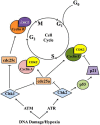Perspectives in cell cycle regulation: lessons from an anoxic vertebrate
- PMID: 20514219
- PMCID: PMC2817888
- DOI: 10.2174/138920209789503905
Perspectives in cell cycle regulation: lessons from an anoxic vertebrate
Abstract
The ability of an animal, normally dependent on aerobic respiration, to suspend breathing and enter an anoxic state for long term survival is clearly a fascinating feat, and has been the focus of numerous biochemical studies. When anoxia tolerant turtles are faced with periods of oxygen deprivation, numerous physiological and biochemical alterations take place in order to facilitate vital reductions in ATP consumption. Such strategies include reversible post-translational modifications as well as the implementation of translation and transcription controls facilitating metabolic depression. Although it is clear that anoxic survival relies on the suppression of ATP consuming processes, the state of the cell cycle in anoxia tolerant vertebrates remain elusive. Several anoxia tolerant invertebrate and embryonic vertebrate models display cell cycle arrest when presented with anoxic stress. Despite this, the cell cycle has not yet been characterized for anoxia tolerant turtles. Understanding how vertebrates respond to anoxia can have important clinical implications. Uncontrollable cellular proliferation and hypoxic tumor progression are inescapably linked in vertebrate tissues. Consequentially, the molecular mechanisms controlling these processes have profound clinical consequences. This review article will discuss the theory of cell cycle arrest in anoxic vertebrates and more specifically, the control of the retinoblastoma pathway, the molecular markers of cell cycle arrest, the activation of checkpoint kinases, and the possibility of translational controls implemented by microRNAs.
Keywords: Cell cycle; Trachemys scripta elegans.; anoxia tolerance; chromatin remodeling; ischemia; microRNA; retinoblastoma.
Figures






Similar articles
-
Evidence for cell cycle suppression and microRNA regulation of cyclin D1 during anoxia exposure in turtles.Cell Cycle. 2012 May 1;11(9):1705-13. doi: 10.4161/cc.19790. Epub 2012 May 1. Cell Cycle. 2012. PMID: 22510561
-
Regulation of p53 by reversible post-transcriptional and post-translational mechanisms in liver and skeletal muscle of an anoxia tolerant turtle, Trachemys scripta elegans.Gene. 2013 Jan 15;513(1):147-55. doi: 10.1016/j.gene.2012.10.049. Epub 2012 Nov 1. Gene. 2013. PMID: 23124036
-
Metabolic adaptations supporting anoxia tolerance in reptiles: recent advances.Comp Biochem Physiol B Biochem Mol Biol. 1996 Jan;113(1):23-35. doi: 10.1016/0305-0491(95)02043-8. Comp Biochem Physiol B Biochem Mol Biol. 1996. PMID: 8936040 Review.
-
Exploration of low temperature microRNA function in an anoxia tolerant vertebrate ectotherm, the red eared slider turtle (Trachemys scripta elegans).J Therm Biol. 2017 Aug;68(Pt A):139-146. doi: 10.1016/j.jtherbio.2016.09.008. Epub 2016 Sep 16. J Therm Biol. 2017. PMID: 28689715
-
Protein lysine methylation in the regulation of anoxia tolerance in the red eared slider turtle, Trachemys scripta elegans.Comp Biochem Physiol Part D Genomics Proteomics. 2020 Jun;34:100660. doi: 10.1016/j.cbd.2020.100660. Epub 2020 Feb 1. Comp Biochem Physiol Part D Genomics Proteomics. 2020. PMID: 32066095 Review.
Cited by
-
Mechanisms, Hallmarks, and Implications of Stem Cell Quiescence.Stem Cell Reports. 2019 Jun 11;12(6):1190-1200. doi: 10.1016/j.stemcr.2019.05.012. Stem Cell Reports. 2019. PMID: 31189093 Free PMC article. Review.
-
The evaluation of anoxia responsive E2F DNA binding activity in the red eared slider turtle, Trachemys scripta elegans.PeerJ. 2018 May 11;6:e4755. doi: 10.7717/peerj.4755. eCollection 2018. PeerJ. 2018. PMID: 29770276 Free PMC article.
-
Chinese Propolis Exerts Anti-Proliferation Effects in Human Melanoma Cells by Targeting NLRP1 Inflammatory Pathway, Inducing Apoptosis, Cell Cycle Arrest, and Autophagy.Nutrients. 2018 Aug 26;10(9):1170. doi: 10.3390/nu10091170. Nutrients. 2018. PMID: 30149677 Free PMC article.
-
Waking the sleeping dragon: gene expression profiling reveals adaptive strategies of the hibernating reptile Pogona vitticeps.BMC Genomics. 2019 Jun 6;20(1):460. doi: 10.1186/s12864-019-5750-x. BMC Genomics. 2019. PMID: 31170930 Free PMC article.
-
Hibernation-Induced microRNA Expression Promotes Signaling Pathways and Cell Cycle Dysregulation in Ictidomys tridecemlineatus Cardiac Tissue.Metabolites. 2023 Oct 19;13(10):1096. doi: 10.3390/metabo13101096. Metabolites. 2023. PMID: 37887421 Free PMC article.
References
-
- Lipton P. Ischemic cell death in brain neurons. Physiol. Rev. 1999;17:1431–1568. - PubMed
-
- Bonetta L. Going on a cancer gene hunt. Cell. 2005;123:735–737. - PubMed
-
- Clegg J.S. Embryos of Artemia franciscana survive four years of continuous anoxia: the case for complete metabolic rate depression. J. Exp. Biol. 1997;200:467–475. - PubMed
-
- Hand S.C. Quiescence in Artemia franciscana embryos: reversible arrest of metabolism and gene expression at low oxygen levels. J. Exp. Biol. 1998;201:1233–1242. - PubMed
LinkOut - more resources
Full Text Sources
